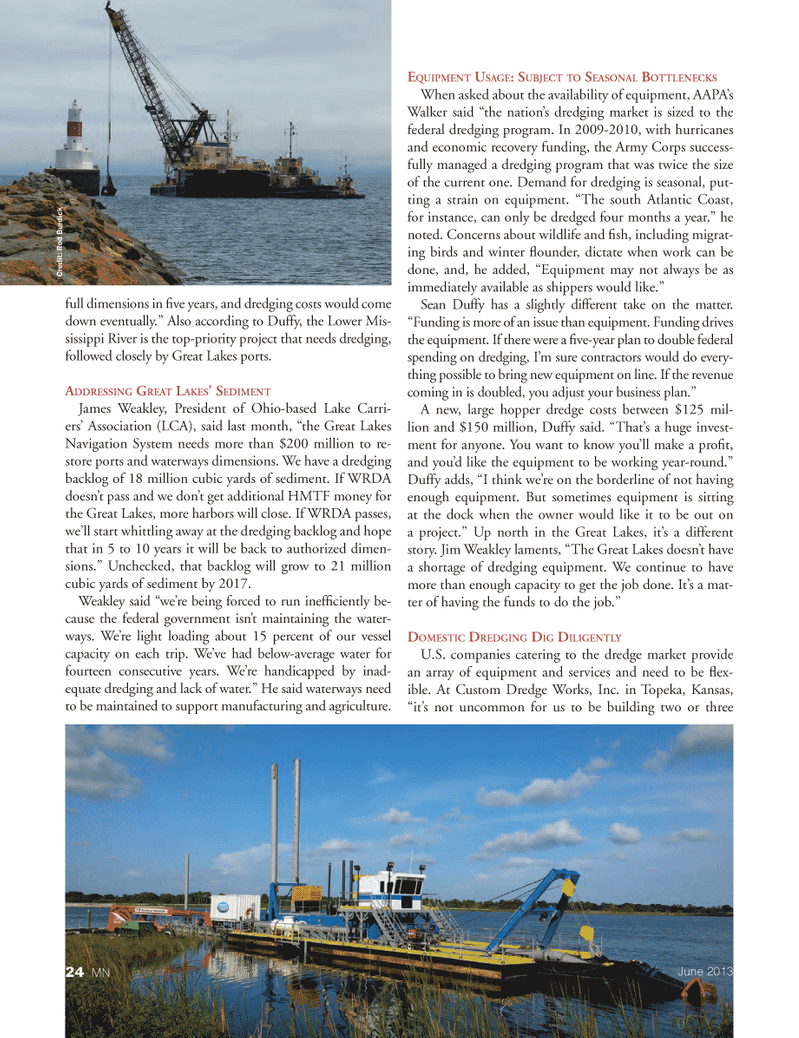
Page 24: of Marine News Magazine (June 2013)
Dredging & Marine Construction
Read this page in Pdf, Flash or Html5 edition of June 2013 Marine News Magazine
full dimensions in Þ ve years, and dredging costs would come down eventually.Ó Also according to Duffy, the Lower Mis- sissippi River is the top-priority project that needs dredging, followed closely by Great Lakes ports. ADDRESSING GREAT LAKES? SEDIMENTJames Weakley, President of Ohio-based Lake Carri- ersÕ Association (LCA), said last month, Òthe Great Lakes Navigation System needs more than $200 million to re- store ports and waterways dimensions. We have a dredging backlog of 18 million cubic yards of sediment. If WRDA doesnÕt pass and we donÕt get additional HMTF money for the Great Lakes, more harbors will close. If WRDA passes, weÕll start whittling away at the dredging backlog and hope that in 5 to 10 years it will be back to authorized dimen- sions.Ó Unchecked, that backlog will grow to 21 million cubic yards of sediment by 2017. Weakley said ÒweÕre being forced to run inefÞ ciently be- cause the federal government isnÕt maintaining the water- ways. WeÕre light loading about 15 percent of our vessel capacity on each trip. WeÕve had below-average water for fourteen consecutive years. WeÕre handicapped by inad- equate dredging and lack of water.Ó He said waterways need to be maintained to support manufacturing and agriculture. EQUIPMENT USAGE : SUBJECT TO SEASONAL BOTTLENECKS When asked about the availability of equipment, AAPAÕs Walker said Òthe nationÕs dredging market is sized to the federal dredging program. In 2009-2010, with hurricanes and economic recovery funding, the Army Corps success- fully managed a dredging program that was twice the size of the current one. Demand for dredging is seasonal, put- ting a strain on equipment. ÒThe south Atlantic Coast, for instance, can only be dredged four months a year,Ó he noted. Concerns about wildlife and Þ sh, including migrat- ing birds and winter ß ounder, dictate when work can be done, and, he added, ÒEquipment may not always be as immediately available as shippers would like.Ó Sean Duffy has a slightly different take on the matter. ÒFunding is more of an issue than equipment. Funding drives the equipment. If there were a Þ ve-year plan to double federal spending on dredging, IÕm sure contractors would do every- thing possible to bring new equipment on line. If the revenue coming in is doubled, you adjust your business plan.Ó A new, large hopper dredge costs between $125 mil- lion and $150 million, Duffy said. ÒThatÕs a huge invest- ment for anyone. You want to know youÕll make a proÞ t, and youÕd like the equipment to be working year-round.Ó Duffy adds, ÒI think weÕre on the borderline of not having enough equipment. But sometimes equipment is sitting at the dock when the owner would like it to be out on a project.Ó Up north in the Great Lakes, itÕs a different story. Jim Weakley laments, ÒThe Great Lakes doesnÕt have a shortage of dredging equipment. We continue to have more than enough capacity to get the job done. ItÕs a mat- ter of having the funds to do the job.Ó DOMESTIC DREDGING DIG DILIGENTLY U.S. companies catering to the dredge market provide an array of equipment and services and need to be ß ex-ible. At Custom Dredge Works, Inc. in Topeka, Kansas, ÒitÕs not uncommon for us to be building two or three Credit: Rod Burdick June 201324 MNMN June2013 Layout 18-31.indd 24MN June2013 Layout 18-31.indd 245/30/2013 11:08:23 AM5/30/2013 11:08:23 AM

 23
23

 25
25
